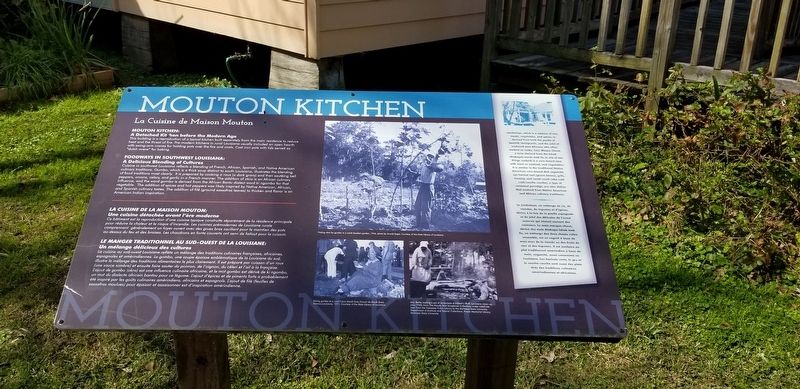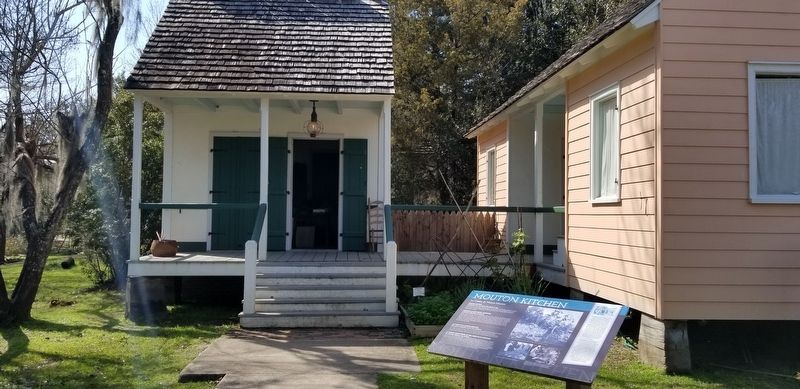Mouton Kitchen
La Cuisine de Maison Mouton
MOUTON KITCHEN:
A Detached Kitchen before the Modern Age
This building is a reproduction of a typical kitchen built separately from the main residence to reduce heat and the threat of fire. Pre-modern kitchens in rural Louisiana usually included an open hearth with swing-arm cranes for holding pots over the fire and coals. Cast iron pots with lids served as "dutch ovens” for baking.
FOODWAYS IN SOUTHWEST LOUISIANA:
A Delicious Blending of Cultures
Cuisine in southwest Louisiana reflects a blending of French, African, Spanish, and Native American
culinary traditions. Gumbo, which is a thick soup distinct to south Louisiana, illustrates the blending
of food traditions most clearly. It is prepared by cooking A Roux (a dark gravy) and then sautéing bell
peppers, onions, celery, and garlic in a French manner. The addition of okra is an African culinary
influence, and the word gombo is derived from the African Bantu dialect word ki ngombo for that
vegetable. The addition of spices and hot peppers was likely inspired by Native American, African,
and Spanish culinary tastes. The addition of filé (ground sassafras leaves) to thicken and flavor is an
American Indian inspiration.
------------------------------------------------------------------------------
LA
CUISINE DE LA MAISON MOUTON:
Une cuisine détachée avant l'ère moderne
Ce bâtiment est la reproduction d'une cuisine typique construite séparément de la résidence principale
pour réduire la chaleur et le risque d'incendie. Les cuisines prémodernes de Louisiane rurale
comprennent généralement un foyer ouvert avec des grues bras oscillant pour le maintien des pots
au-dessus du feu et des braises. Les chaudrons
en fonte couverts ont servi de faitout pour la cuisson.
LE MANGER TRADITIONNEL AU SUD-OUEST DE LA LOUISIANE:
Un mélange délicieux des cultures
La cuisine au sud-ouest Louisiane reflète un
mélange des traditions culinaires françaises, africaines, espagnoles et amérindiennes. Le gombo,
une soupe épaisse emblématique de la Louisiane du sud,
illustre le mélange des traditions alimentaires le plus clairement. Il est préparé par cuisson d'un roux
(une sauce sombre) et ensuite faire sauter du poivron, de l'oignon, du céleri et l'ail à la française.
L'ajout de gombo (okra) est une influence culinaire africaine, et le mot gombo est dérivé de ki ngombo
un mot du dialecte africain bantou pour ce légume. L'ajout d'épices et de piments forts a probablemen
été inspiré par les goûts culinaires amérindiens, africains et espagnols. L'ajout de filé (feuilles de
sassafras moulues) pour épaissir et assaisonner est
Jambalaya, which is a mixture of rice,
meats,vegetables, and spices, is
derived from both the paella of
Spanish immigrants,and the jolof of
enslaved west Africans who often
worked as cooks. Corn Maque Choux,
a term derived from the Ishak
(Atakapa) words mak tiu (a mix of two
things cooked) is a corn-based stew
with meat or seafood, and vegetables.
It is similar to the traditional Native
American corn-based dish sagamité.
Les haricot vert (green beans), grits,
hominy,and coush coush (aka cush
Cush/couche couche),
a type of
cornmeal porridge,
are also dishes
that evolved from Native American
and African culinary traditions.
-----------------------------------------------------------------------------------------
Le jambalay,
un mélange de riz, de
viandes, de légumes et d'épices,
dérive à la fois de la paella espagnole
et du jolof des Africains de l''ouest
asservis qui étaient souvent des
cuisiniers. Le maïs macque-choux,
dérivé des mots Atakapa-Ishak mak
mélange des deux choses cuites
tiu,
un
ragoût à base de
ensemble, est un
mais avec de la viande ou des fruits de
mer et des légumes. Il est similaire au
plat traditionnel amérindien à base de
mais,sagamité, aussi consommé en
Louisiane. Les haricots verts, le gru et
le couche-couche sont aussi des plats
tirés des traditions
Topics. This historical marker is listed in this topic list: Settlements & Settlers.
Location. 30° 12.922′ N, 91° 59.68′ W. Marker is in Lafayette, Louisiana, in Lafayette Parish. Marker can be reached from Fisher Road near Surrey Street (State Road 728-8). Touch for map. Marker is at or near this postal address: 300 Fisher Road, Lafayette LA 70508, United States of America. Touch for directions.
Other nearby markers. At least 8 other markers are within walking distance of this marker. Mouton House (a few steps from this marker); The Forge (a few steps from this marker); School House (within shouting distance of this marker); Acadian House (within shouting distance of this marker); Buller House (within shouting distance of this marker); Beau Bassin House (within shouting distance of this marker); Trappers Cabin & Boat Shed (within shouting distance of this marker); The Presbytery (within shouting distance of this marker). Touch for a list and map of all markers in Lafayette.
More about this marker. Located on the grounds of the Vermilionville Historic Village, a living history museum. Fee is charged for access to museum grounds.
Also see . . . Vermilionville. Museum website homepage (Submitted on June 9, 2019, by Cajun Scrambler of Assumption, Louisiana.)
Credits. This page was last revised on December 25, 2023. It was originally submitted on June 9, 2019, by Cajun Scrambler of Assumption, Louisiana. This page has been viewed 292 times since then and 41 times this year. Photos: 1, 2. submitted on June 9, 2019.

